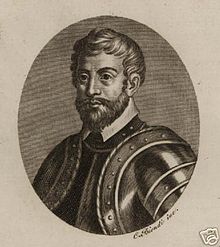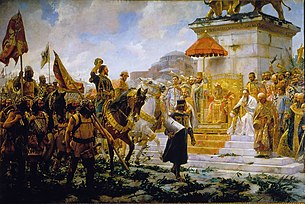Roger de Flor
Roger de Flor | |
|---|---|
 | |
| Born | 1267 Brindisi, Kingdom of Sicily (modern-day Italy) |
| Died | 30 April 1305 (aged 37–38) Adrianople, Byzantine Empire (modern-day Edirne, Turkey) |
| Allegiance | Crown of Aragon Catalan Company |
| Years of service | 1282–1305 |

by José Moreno Carbonero
Roger de Flor (1267 – 30 April 1305), also known as Ruggero/Ruggiero da Fiore or Rutger von Blum or Ruggero Flores, was an Italian military adventurer and
Biography
Roger de Flor was born in
At eight years old Roger de Flor was sent to sea in a
The struggle between the Aragonese
Emperor
Facing strong opposition from the powerful Genoese, some weeks passed lost in dissipation, intrigues, and bloody quarrels against the Genoese who were intent on keeping him out of the circles of power. Roger and his men were sent into
Being recalled to Europe, he settled his troops in Gallipoli and other towns, and visited Constantinople to demand pay for the Almogavars. Roger was created Caesar, perhaps in December 1304; other sources indicate that the date was shortly before Roger's death ("in 1305 the title of Caesar, which conferred great ceremonial status, though less real power") [5] and even days before ("Flor being promoted kaisar in April 1305").[6]
In April 1305, he was assassinated in
He was fluent in Greek.[8]
Adaptations
The early history of the Catalan Company was chronicled by Ramon Muntaner, a member of the company, in his Crònica.
The life of Roger de Flor inspired the fictional character of
Roger de Flor is one of the main characters of The Horsemen of Death ("Surma ratsanikud"; 1963), a historical novel by Estonian writer Karl Ristikivi. Roger de Flor is the title and the main character of a historical novel by the late Greek writer and publisher Kostas Kyriazis.
Spanish poet Mariano Capdepón composed a play dealing with the last days of Roger's life. The composer Ruperto Chapí used this text for his opera Roger de Flor (1878).
One of the units of the
Notes
Citations
- ^ a b Dupuy (2003), p. 329.
- ^ Waley (1985), p. 164.
- ^ Pavlov (2005).
- ^ Korobeinikov (2014), pp. 285–286.
- ^ David Abulafia, The Western Mediterranean Kingdoms: The Struggle for Dominion, 1200-1500 (Taylor & Francis, 2014) p.121
- ^ "The Catalan Company in the East", by David Jacoby, in The Medieval Way of War: Studies in Medieval Military History in Honor of Bernard S. Bachrach ed. by Gregory I. Halfond (Routledge, 2016) p. 155
- ^ a b Burns (1954), p. 752.
- ISBN 978-1-317-02419-4.
References
- This article incorporates text from a publication now in the public domain: Chisholm, Hugh, ed. (1911). "Flor, Roger di". Encyclopædia Britannica (11th ed.). Cambridge University Press.
- Burns, R. Ignatius (October 1954). "The Catalan Company and the European Powers, 1305–1311". Speculum. 29 (4): 751–771. S2CID 162223403.
- Dupuy, Mark (2003). Kagay, Donald Joseph; Villalon, L.J. Andrew (eds.). "The Master's Hand and the Secular Arm:Property and Discipline in the Hospital of St. John in the Fourteenth Century". Crusaders, Condottieri, and Cannon: Medieval Warfare in Societies Around the Mediterranean. Brill.
- Korobeinikov, Dimitri (2014). Byzantium and the Turks in the Thirteenth Century. Oxford University Press.
- Pavlov, Plamen (2005). "Allies and Followers of Ivaylo". LiterNet (in Bulgarian). LiterNet Electronic Publishing House. Retrieved 23 April 2021.
- Waley, Daniel (1985). Later Medieval Europe (2nd ed.). New York: Longman Inc. ISBN 0-582-49262-9. Retrieved 23 April 2021.
General references
- Ernest Marcos Hierro, Almogàvers: la història, L'esfera dels llibres, Barcelona 2005.
- Francisco de Moncada, Catalan Chronicle.
